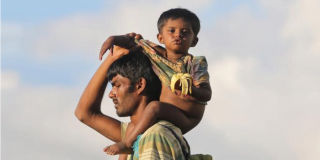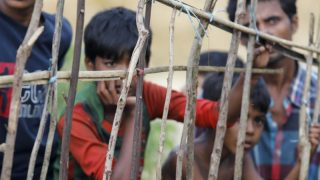A year or so ago I met a group of Burmese refugees living a shadowy existence in Malaysia. I was in Kuala Lumpur for a conference, staying in a large and luxurious hotel suite that was ridiculously cheap. My refugee friends were also living in Kuala Lumpur. They rented a spartan apartment in a seedy apartment block that was just a 10 minute walk from my motel. The monthly rental was almost the equivalent of one month’s wage for a refugee working illegally, so three families crowded into the tiny 2 bedroom unit. A makeshift wall was erected down the middle of an already small living room to make a third bedroom.
Refugees in Malaysia are free to live in the community, but life is difficult. There are no benefits and it is illegal to work. The government, presumably needing cheap labour for a growing economy, turns a blind eye to refugees finding employment, but their illegal status means the jobs are extremely low pay and worker rights are easily violated. I heard stories of employers refusing to pay refugees who had worked for them for months.
Medical expenses can be crippling. Refugees are required to pay the full cost of their hospitalisation. I was told of one gentleman who had been hit by a car, needed surgery, and received a bill that was the equivalent of a year’s wages. His story was not unusual. To cope with this the Chin refugee community had developed their own safety net: whenever anyone was hospitalised everyone would contribute to the costs.
Malaysian schools are closed to refugee children. Given refugees can spend years waiting for resettlement this is a major problem for children and their families. Again the Chin community had a working solution – they formed their own schools, staffing them with volunteers from the Chin and Malaysian community. Still, the schools are deplorable by Australian standards – very large classes, children crowded into small meting spaces, and little equipment.
What would drive people to endure such circumstances? Oppression. One of the refugees, a young man names Jonas (I’ve changed his name to protect his identity) was subject to over thirty instances of forced labour by the Burmese army. He told me that on the last occasion he was forced at gunpoint to cook and clean at a military camp. After a month he fled. Another of the refugees, a mother, told me how the Burmese government failed to provide medical services to Chin state. This was part of a policy of bastardisation, in which the Burmese regime seeks to pacify minorities. Services are refused to Chin people, their children are forced to attend schools where they are indoctrinated into Buddhism, and the military routinely brutalise and enslave people. This mother, with a severely disabled child, saw no option but to leave.
Hearing these stories I understand why people get on leaky, overcrowded boats to come to Australia. The constant fear, deprivation and trauma of life as a refugee extinguishes hope for many. Chin leaders told me how despair induced drunkeness and alcohol fueled violence were a growing problem. Others cling to hope of resettlement in a country like Australia. Others become so desperate they get on boats.
In light of this I find myself disgusted by the way ‘boat people’ have become a political football in Australia. Yes, many of our politicians have been deeply moved by the recent drownings of asylum seekers, but there was an ugly wedging going on well before this that belies the newly found compassion. And I suspect it is this ugly politicisation that is driving the pathetic focus on stopping the boats by stripping human beings of their rights. The mantra seems to be that if we make life tough enough for refugees they won’t come. Send them to Malaysia where there is no hope of repatriation. Lock them up on Nauru. Only give them temporary protection.
The best ‘solution’ I have heard comes from the eminent QC, Julian Burnside: take more refugees from Malaysia and Indonesia. At the end of 2011 there were roughly 3,000 refugees and asylum seekers in Indonesia and 90,000 in Malaysia*. These are the two main staging points for boats coming to Australia, yet each year Australia takes only 50 or so refugees from Indonesia and 400 or so from Malaysia. If we upped our annual humanitarian immigration numbers from the current 14,000 to 20,000 or 30,000 and as part of that upped our intake from Malaysia and Indonesia, asylum seekers in those countries would have much greater hope that they would be resettled in a short period of time and so much less incentive to get on boats.
Above all, we must lift our sights beyond ‘border protection’, where the focus is on us, to ‘people protection’, where the focus is how we love our refugee neighbours
* Data for Indonesia and Malaysia taken from http://www.aph.gov.au/About_Parliament/Parliamentary_Departments/Parliamentary_Library/pubs/BN/2011-2012/RefugeeResettlement#_Toc310921312







Amen
Increase the humanitarian intake, and speed up the Australian processing in countries like malaysia and indonesia!